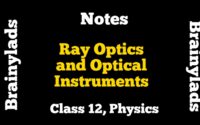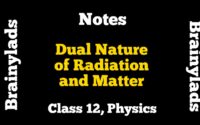Nuclei Notes Class 12 | Term 2 | Physics | NCERT |
Table of Contents
Nuclei Notes Class 12 | Term 2 | Physics | NCERT |
Nuclei
In every atom, the positive charge and mass are densely concentrated at the centre of the atom forming its nucleus. More than 99.9% mass of the atom is concentrated in the nucleus.
Atomic Mass Unit (amu) : The unit to express atomic masses is called atomic mass
unit. Atomic mass unit is defined as 1/12 th of the mass of carbon atom (C12).
Composition of Nucleus
The composition of a nucleus can be described by using the following terms and symbols.(i) Atomic Number Z Atomic number of an element is the number of protons present inside the nucleus of an atom of the element.
Atomic number = Number of protons = Number of electrons
(ii) Mass Number A Mass number of an element is the total number of protons and neutrons inside the atomic nucleus of the element.
Mass number = Number of protons + Number of neutrons = Number of electrons + Number of neutrons i.e. A=Z.+ N
Size of Nucleus : If R is the radius of the nucleus having mass number A, then
Nuclear Density : Density of nuclear matter is the ratio of mass of nucleus and its volume.
Radioactivity : It is the phenomenon of spontaneous disintegration of the nucleus of an atom with emission of one or more radiations like α-particle, β-particle or γ-rays.
Radioactive Decay : It is a nuclear transformation process in which the radioactive rays are emitted from the nucleus of the atom. This process cannot be accelerated and slow down by any physical or chemical process.
Radioactivity Decay Law : According to this law, the rate of decay of radioactive atoms at any instant is proportional to the number of atoms present at that instant.
Half-life : Half-life of a radioactive element is defined as the time during which half the number of atoms present initially in the sample of the element decay.
Mean Life/Average Life : Average life of a radioactive element can be obtained by calculating the total life time of all the atoms of the radioactive element and dividing it by the total number of atoms present initially in the sample of the element.
Time required to decay from N0 to N
Decay Constant : The radioactive decay constant may be defined as the reciprocal of the time during which the number of atoms in a radioactive substance reduces to 36.8% of their initial number.
Radioactive Displacement Law : The law of radioactive displacement is also known as Fajan’s and Soddy law. This law describes which chemical element and isotope is created during the particular type of radioactive decay.
(i) α- Decay In α-decay, the mass number of the product nucleus is four less than that of decaying nucleus while the atomic number decreases by two.
(ii) β-Decay In β-decay, the mass number of product nucleus remains same but atomic number increases or decreases by one.
In beta-minus decay (β– ),an electron and an antineutrino are created and emitted from the nucleus via the reaction given below:

(iii) γ-Decay A γ- ray is emitted when a or β-decay results in a daughter nucleus in an excited state. Atom then returns to ground state by a single photon transition or successive transitions involving more than one photon.
The SI unit of radioactivity is Becquerel (Bq).
1 Becquerel(Bq) = 1 disintegration/second Other units
1 curie (Ci) = 3.7 x 1010 decays/second
(ii) Rutherford : The activity of a radioactive sample is said to be one rutherford.
1 rutherford (Rd) = 106 decays/second.
Related
Nuclear Reactor
- Nuclear reactors are useful in producing electricity.
- A nuclear reactor is an arrangement to generate electricity whichmakes use of nuclear fission.
Requirements for Controlled Nuclear Fission in Reactor:
- Neutrons to be slowed down.
- Neutrons are slowed down by using moderators which are lighter nuclei which slow down fast moving neutrons by elastic collision.
- Commonly used moderators:-
- Water
- Heavy Water
- Graphite
Consequence of Use of Moderators
-
- Multiplication factor of neutrons increases: When a neutron hits a target nucleus along with daughter nucleus,it produces 3 neutrons.These 3 neutrons are highly energetic but they need to be slowed down, so they can hit the target nucleus.
- As a result high multiplication factor results in uncontrolled chain reaction.
- Excess neutrons to be absorbed.
- As uncontrolled chain reaction is wanted therefore to absorb excess neutrons Control Rods are used.
- These control rods are inserted in the core of the nuclear reactor.
- Control rods are capable of initiating(while taking out of the reactor) and stopping(inserting in the nuclear reactor) the nuclear reaction.
- As they absorb all the excess neutronsthere are no neutrons left to start the reaction.
- Control rods are made up of neutron absorbing materials.
- They decrease the multiplication factor of neutrons to a very small value.
- Commonly used material is Cadmium.
Control Rods
Construction of Nuclear Reactor
- The core of the nuclear reactor consists of uranium (235U) in the form of cylindrical rods. These rods are dipped inside a liquid which is the moderator.
- Whenever one neutron strikes this uranium rod nuclear fission reaction starts and 3 fast moving neutrons are produced.
- Because of the moderator these 3 neutrons undergo elastic collision as a result they slow down before they strike the second rod.
- Geometry of the core is such that only one out of 3 neutrons which are emitted strike the next rod making the reaction a controlled one.
- When the control rods are inserted inside they will absorb all the extra neutrons. Since there are no neutrons nuclear fission reaction will stop.
- Large amount of energy is also released in the core.
- In order to extract the energy from the core water at very high pressure is passed through it.
- As hot water passes through it produces steam in the steam generators.
- This steam is used to run the turbines which in turn produce electricity.
- This process will keep on continuing till the uranium on the rods does not get over.Then the rods have to be replaced in the nuclear reactor.
Advantages:
- Energy released is extremely large.
- Needs fuel in extremely small quantity.
Disadvantages:
- Spent fuel is highly radioactive and extremely hazardous to all life forms.
- Accumulation of radioactive waste.
Nuclear Fusion
- In a nuclear fusion reaction two lighter nuclei combine to form a relatively heavier nucleus.
- In this process huge amount of energy is also released.
- Temperature at which protons would have enough energy to overcome the coulomb’s barrier is very high.
Thermonuclear fusion
- Increasing the temperature of the material until the particles have enough energy due to their thermal motions alone –to overcome the coulomb barrier.
- For thermonuclear fusion,extreme conditions of temperature and pressure are required.
- Example of Thermonuclear fusion is generation of energy in stars.
For example: From the sun we get large amount of energy and this energy generated due to the thermonuclear fusion reaction taking place in the sun.
Energy Generation in Sun
- In sun the energy generation is a multi- step process.There are total of 4 steps involved in the energy generation inside sun.
- Step1:- 11H(proton) + 11H(proton) –>21H(deuteron)+ e+(positron) + ν(neutrino)+0.42MeV
- Step2:- e+(positron) + e–(electron) –>γ(Gamma rays) + 1.02MeV
- Step3:- 21H(deuteron)+ 11H(proton) –>32He(helium) + γ(Gamma rays)+5.49MeV
- Step4:- 32H + 32H –>42He + 11H+11H+12.86MeV
- Step 1,2,and 3 occur twice in the sun and the step 4 occurs only once.
- When all the above 4 reactions are combined together then four hydrogen atoms combine to form a42He atom with a release of 26.7MeV of energy.
- Final reaction is:- 411H +2e– –> 42He +6 γ+2 ν+26.7MeV
- It is also known as proton-proton cycle because this process starts with protons.
Nuclear Fission
- Scientist named Fermi was the one who performedfirst nuclear fission reaction.
- He considered the sample of 92235U and bombarded it with a neutron 10n i.e.
- 10n + 92235U(Target nuclei)à92236U(unstable so broke down into) –>56144Ba + 8936kr +310n
- Where (56144Ba) = Barium,(8936kr)=Krypton and (10n) =neutron.
- This reaction is known as nuclear fission reaction as heavier nuclei is broken down into lighter nuclei, thereby releasing large amounts of energy.
- 10n + 92235U(Target nuclei)à92236U(unstable so broke down into) –>56144Ba + 8936kr +310n
Types of Nuclear Fission Reactions:
- Uncontrolled chain reaction:-
- In uncontrolled chain reaction, the reaction is uncontrolled and rapid.The reaction keeps increasing and becomes huge.
- Energy of the order of mega electron volts is produced.
- This reaction is known as chain reaction as the product formed in first reaction initiates the second reaction and so on.
- One of the important applications of this reaction is in making atom bombs,hydrogen bombs and nuclear bombs.
- (Number of neutrons hitting next target)/ (number of neutrons emitted)>=1.
- Reaction that takes place :-
- 10n + 92235U –>92236U(unstable so broke down into) –>56144Ba + 8936kr +3 10n
- Controlled chain reaction:-
- In controlled chain reaction, the reaction is controlled and steady.
- Reaction that takes place :-
- 10n + 92235U –> 92236U(unstable so broke down into) –>56144Ba + 8936kr +3 10n
- Using some methods 2 neutrons are removed and only 1 neutron is allowed to hit the next target.
- Energy released is less as compared to the energy released in the nuclear fission reaction.
- One of the most important applications is in Nuclear Reactor where electricity can be produced.
- (Number of neutrons hitting next target)/ (number of neutrons emitted)<1.
Nuclear Energy
- Nuclear energy is the energy that holds together the nuclei of atoms.
- Nuclear energy is obtained from nucleus by either:-
- Breaking of heavy nucleus into 2 relatively lighter nuclei known as nuclear fissionor by
- Combining 2 lighter nuclei to form a heavy nucleus known as nuclear fusion.
- Nuclear energy is becominga possible solutionfor the energy crisis in the world.
- Electric energy can be harnessed from nuclear energy.
Nuclear reactor
Types of Nuclear Reactions
Do share this post if you liked Nuclei Notes Class 12 Term 2 Physics. For more updates, keep logging on BrainyLads.





















